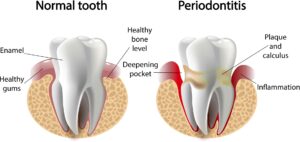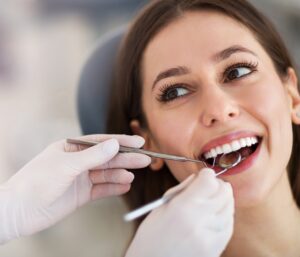Header logo
header top contact widget
Learn More Blog
Know How Oral Bacteria Form & Cause Damage
Posted on Nov 07, 2023 by William J. Claiborne, DDS MS
Often, once people understand how something breaks down, they are able to watch for telltale signs or take preventive measures. For example, when the grooves in a vehicle’s tires become more shallow, it’s obvious they need to make arrangements for new tires.
This is true, also, for your oral health. Knowing concerning oral signs and symptoms can help you prevent cavities, periodontal (gum) disease and tooth loss.
Oral bacteria exists in every mouth; some of it is “good” bacteria. The good bacteria are even helpful to the digestive system. However, harmful bacteria can run rampant if not kept under control.
The average mouth houses around 20 billion (that’s billion with a “b”), consisting of about 700 different types. Bacteria breed very quickly. The numbers can grow amazingly fast and their buildup produces a bacterial film that coats the teeth and gums. This is known as plaque.
Plaque is the sticky coating in your mouth, most obvious when you first wake up. When plaque is not removed regularly (through thorough brushing), the bacteria attack tooth enamel. Results include bad breath, yellowed teeth, cavities and tender gums.
Plaque formation actually begins as you chew carbohydrates, which seems to be prevalent in most of the foods we eat in today’s diet. As carbohydrates blend with saliva and existing bacteria in the mouth, an acid is created.
Plaque that is allowed to remain on teeth for about 48 hours hardens. This is known as tartar, which is a mass of bacteria that forms between and at the base of teeth.
Once in this hardened form, removal can only occur with special tools used by your dentist or dental hygienist. This is what your hygienist is scraping off during cleanings. Without tartar being removed, it causes the gums to swell, feel tender and may bleed when brushing. This is typically the initial stage of gum disease, known as gingivitis.
However, for people who brush twice a day and still have tartar formation between dental hygiene appointments, there are factors that may be contributing. Some of these are not common knowledge, which is important to know in your prevention goals. These include:
Having “dry mouth”: There are a number of reasons that some people suffer with a drier mouth than others. Unfortunately, those who have insufficient saliva flow (which continually helps to cleanse the mouth) are more susceptible to tooth decay from plaque and tartar.
Saliva protects teeth and gums by helping to manage the growth of harmful bacteria while maintaining a neutral pH in the mouth. This slows microbial growth and keeps bacteria from sticking to teeth.
Other contributors to dry mouth include aging, caffeine (including coffee, tea, sodas, and chocolate), smoking, and a wide range of medications (such as antidepressants, decongestants and diuretics).
Poor oral hygiene: Since the pandemic, normal routines have been uprooted for many people as they have adjusted their “ready for the day” tasks to more casual timetables. Unfortunately, this seems to have left the habitual brushing and flossing times to days where oral hygiene has dropped out of the twice-a-day routine.
A March 2023 poll (conducted on behalf of CeraVe) included 2,000 men between the ages of 18 – 42. They found that only 54% brush their teeth daily (with one-third admitting to only once a day when they do brush). To no surprise, a recent report by the Centers for Disease Control & Prevention reveals that nearly 26% of ages 20 – 44 have untreated dental caries.
Frequent snacking: Every time you eat or drink, an acid attack begins in the mouth. This acid flows in with saliva to begin the initial stage of digestion. However, this acid is very potent, enough to even soften tooth enamel. So, every time you take a bite of a cookie, acid flows into the mouth and remains there for about 20-30 minutes. When the mouth endures frequent acid attacks from snacking between meals, the damage to precious tooth enamel will catch up to you in the form of cavities.
In addition to the harm that oral bacteria can cause teeth, the gum tissues – essentially the protective coating to the vital structures that support teeth – endure the rigors of bacterial overload. Eventually, this catches up to most people in the form of:
• Gingivitis – As the initial stage of gum disease, inflammation is triggered by plaque buildup at the gum line. When daily brushing and flossing fail to thoroughly remove plaque, toxins form that cause irritation to the gum tissues. Once symptoms emerge, they may include seeing blood in the sink when brushing or having sore, swollen gums.
• Periodontitis – As the disease advances, the bone structures and fibers that support teeth are damaged by the destruction of infectious oral bacteria. At this stage, pockets form below the gum line, filling with bacteria-laden plaque.
• Advanced Periodontitis – In the advanced stage of gum disease, fibers and bone supporting natural teeth are destroyed. This can cause teeth to shift or loosen, requiring aggressive treatment to prevent tooth loss. Eventually, some teeth may require removal.
Proactive measures NOW can help you avoid costly repairs to teeth, tooth replacement or the treatment process to rid periodontal disease. Start now with:
– Brush twice daily, floss every day and maintain regular dental check-ups. Thorough at-home oral care and regular dental check-ups can help you avoid problems from occurring in the first place.
– Delay brushing after eating or drinking. Wait 20-30 minutes to allow the acid attack in your mouth to subside. Remember, this acid can soften tooth enamel. The abrasiveness of a tooth brush or tooth paste can wear away precious tooth enamel.
– Swish with water. Enjoy a cup of coffee or glass of wine but try to alter these with a glass of water, allowing it to wash over teeth before swallowing. Or, swish with water.
– Eat sweets only with meals. Rather than forgo a sweet indulgence as a snack, enjoy your favorites as dessert following your meal since your mouth is already enduring an acid attack. This merely prolongs an acid attack rather than trigger a new one.
A healthy mouth is important for your overall health, as research has shown. We now know that the inflammatory bacteria of periodontal (gum) disease are able to enter the bloodstream through tears in weakened gum tissues. Numerous studies have found this bacteria can trigger harmful reactions.
For example, the bacteria can cause inflammation that sets into motion risks factors connected to arthritis and diabetes. Some cancers have also been correlated to this bacteria. Heart disease, stroke and high blood pressure have been as well. Alzheimer’s is also being studied along these lines.
While there is no clear pathway to verify gum disease bacteria are the “cause” of these serious conditions, research has continually shown they are linked, which can greatly increase one’s potential for having these problems develop (or worsen).
If you haven’t been fully committed to your oral health, there is no better time to begin than the present. Start with a thorough periodontal examination by calling 828-274-9440.
If dental fears have caused you to delay or avoid regular dental care, consider beginning with a consultation. This occurs in a comfortable, private room that is removed from the clinical side of the office. Too, many treatments can include oral or IV sedation (sleep dentistry, or “twilight sleep”).
And, if budget constraints are an obstacle, we offer several payment plans. Most are interest-free with no down payment required (for qualified individuals). Feel free to ask about these during your consultation.
Sources:
www.todaysrdh.com/
perio.org
Recent Posts
Categories
Archives
- September 2024
- August 2024
- July 2024
- June 2024
- May 2024
- April 2024
- March 2024
- February 2024
- January 2024
- December 2023
- November 2023
- October 2023
- September 2023
- August 2023
- July 2023
- June 2023
- May 2023
- April 2023
- March 2023
- February 2023
- January 2023
- December 2022
- November 2022
- October 2022
- September 2022
- August 2022
- July 2022
- June 2022
- May 2022
- April 2022
- March 2022
- February 2022
- January 2022
- December 2021
- November 2021
- October 2021
- September 2021
- August 2021
- July 2021
- June 2021
- May 2021
- April 2021
- March 2021
- February 2021
- January 2021
- December 2020
- November 2020
- October 2020
- September 2020
- August 2020
- July 2020
- June 2020
- May 2020
- April 2020
- March 2020
- February 2020
- January 2020
- December 2019
- November 2019
- October 2019
- September 2019
- August 2019
- July 2019
- June 2019
- May 2019
- April 2019
- March 2019
- February 2019
- January 2019
- December 2018
- November 2018
- October 2018
- September 2018
- August 2018
- July 2018
- June 2018
- May 2018
- April 2018
- March 2018
- February 2018
- January 2018
- December 2017
- November 2017
- October 2017
- September 2017
- August 2017
- July 2017
- June 2017
- May 2017
- April 2017
- March 2017
- February 2017
- January 2017
- December 2016
- November 2016
- October 2016
- September 2016
- August 2016
- July 2016
- June 2016
- May 2016
- April 2016
- March 2016
- February 2016
- January 2016
- December 2015
- November 2015
- October 2015
- September 2015
- August 2015
- July 2015
- June 2015
- May 2015
- April 2015
- March 2015
- February 2015
- January 2015
- December 2014
- November 2014
- October 2014
- September 2014
- August 2014
- July 2014
- June 2014
- May 2014
- April 2014
- March 2014
- February 2014
- January 2014
- December 2013
- November 2013
- October 2013
- September 2013
- August 2013
- July 2013
- June 2013
- May 2013
- April 2013
- March 2013
- February 2013
- January 2013
- December 2012
- November 2012
- October 2012
- September 2012
- August 2012
- July 2012
- June 2012

